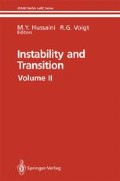Abstract
Compressible linear viscous stability theory is used to study the effect of combined wall suction and cooling on the second mode instability in a flat plate boundary layer. While wall cooling destabilizes the boundary layer, calculations at Mach 4.5 and 8 show that wall suction may be used to stabilize the boundary layer with respect to second mode (subsonic) instability.
Access this chapter
Tax calculation will be finalised at checkout
Purchases are for personal use only
Preview
Unable to display preview. Download preview PDF.
References
Lees, L. and Lin, C. C., “Investigation of the Stability of the Laminar Boundary Layer in a Compressible Fluid”, NACA Technical Note No. 1115, 1946 (unpublished).
Mack, L. M., “Boundary-Layer Stability Theory”, Document No. 900–277, Rev. A, Jet Propulsion Laboratory, Pasadena, CA, 1969.
Lees, L., “The Stability of the Laminar Boundary Layer in a Compressible Fluid”, NACA Tech. Report No. 876, 1947.
Malik, M. R., “Prediction and Control of Transition in Hypersonic Boundary Layers”, AIAA 19th Fluid Dynamics, Plasma Dynamics and Lasers Conference, Honolulu, Hawaii, June 8–10, 1987, AIAA Paper No. 87–1414,1987 (unpublished).
Mack, L. M., “On the Inviscid Acoustic-Mode Instability of Supersonic Shear Flows,”, Fourth Symposium on Numerical and Physical Aspects of Aerodynamic Flows”, California State University, Long Beach, CA, January 16–19, 1989.
Malik, M. R., Chuang, S. and Hussaini, M. Y., ZAMP 33. 189 (1982).
Malik, M. R., “Numerical Methods for Hypersonic Boundary Layer Stability”, HTC Report No. 88–6, June 1988.
Mack, L. M., “Boundary-Layer Linear Stability Theory”, in Special Course on Stability and Transition of Laminar Flow, AGARD Report No. 709, pp. 3–1 to 3–81, 1984.).
Author information
Authors and Affiliations
Editor information
Editors and Affiliations
Rights and permissions
Copyright information
© 1990 Springer-Verlag New York Inc.
About this paper
Cite this paper
Malik, M.R., Godil, A.A. (1990). Effect of Wall Suction and Cooling on the Second Mode Instability. In: Hussaini, M.Y., Voigt, R.G. (eds) Instability and Transition. ICASE/ NASA LaRC Series. Springer, New York, NY. https://doi.org/10.1007/978-1-4612-3432-6_18
Download citation
DOI: https://doi.org/10.1007/978-1-4612-3432-6_18
Publisher Name: Springer, New York, NY
Print ISBN: 978-0-387-97324-1
Online ISBN: 978-1-4612-3432-6
eBook Packages: Springer Book Archive

